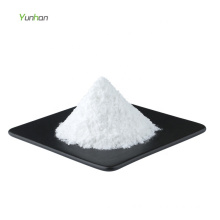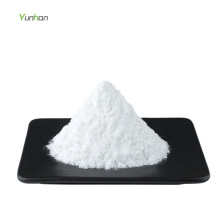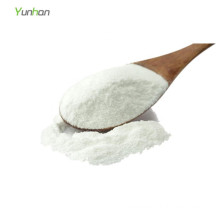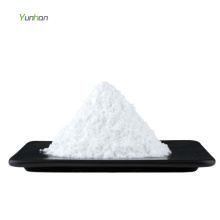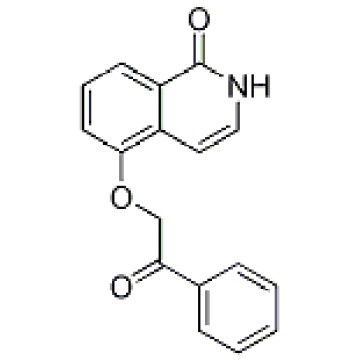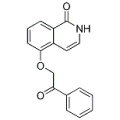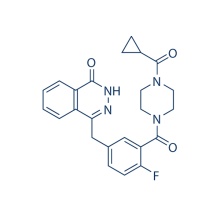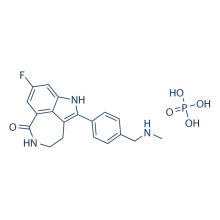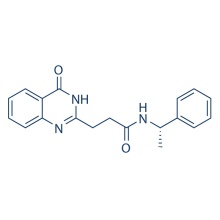UPF 1069 1048371-03-4
Product Description
.cp_wz table {border-top: 1px solid #ccc;border-left:1px solid #ccc; } .cp_wz table td{border-right: 1px solid #ccc; border-bottom: 1px solid #ccc; padding: 5px 0px 0px 5px;} .cp_wz table th {border-right: 1px solid #ccc;border-bottom: 1px solid #ccc; padding: 5px 0px 0px 5px;}
Molecular Weight:
279.29 UPF 1069 is a selective PARP2 inhibitor with IC50 of 0.3 μM. It is ~27-fold selective against PARP1.
Biological Activity
UPF 1069 is a selective PARP2 inhibitor with IC50 of 0.3 μM while inhibiting PARP1 with IC50 of 8 μM.
In organotypic hippocampal slices, PARP-2 inhibition with UPF-1069
(0.01-1 mM) causes a concentration-dependent exacerbation (up to 155%)
of oxygen-glucose deprivation (OGD)-induced CA1 pyramidal cell death.
Higher concentrations, acting on both PARP-1 and PARP-2, have no effect
on OGD injury. In mouse mixed cortical cells exposed to OGD, UPF-1069
(1-10 mM) significantly reduces post-ischaemic damage.
PARP-1 and PARP-2 activity assays
PARP activity is evaluated by utilizing commercially available
recombinant bovine PARP-1 and mouse PARP-2. Briefly, the enzymatic
reaction is carried out in 100 mL of 50 mM Tris-HCl (pH 8.0) containing 5
mM MgCl2, 2 mM dithiothreitol, 10 mg sonicatedcalf thymus DNA, 0.2 mCi [adenine-2,8-3H]NAD
and recombinant enzyme PARP-1 or PARP-2 (0.03 U per sample). Different
concentrations of the putative Inhibitors are added, and the mixture is
incubated for 1 h at 37℃. The reaction is terminated by adding 1 mL of
10% trichloroacetic acid (w/v) and centrifuged.
Pellets are then washed
twice with 1 mL of H2O and resuspended in 1 mL of 0.1 M NaOH. The radioactivity incorporated from [adenine-2,8-3H]NAD into Proteins is evaluated by liquid scintillation spectrometry.
Nuclear extracts for PARP activity assay are prepared from PARP-1-/- and PARP-1+/+ mouse fibroblasts as previouslydescribed. Briefly, immortalized fibroblasts from PARP-1-/- and PARP-1+/+ mice are grown in DMEM supplemented with 2 mM glutamine, 10% bovine
serum and antibiotics at 37℃.
Nuclear extracts are prepared as follows:
10 cm confluent plates are scraped in 1 mL of homogenization buffer
composed of 75 mM sucrose, 225 mM mannitol and 5 mM Tris, pH 7.4
plus 10 mL protease inhibitor cocktail. The cell suspension is
homogenized with a Teflon pestle, and the mixture is centrifuged at 600
× g for 5 min at 4℃. The crude nuclear pellet is washed and
resuspended in 1 mL of PARP assay buffer (5 mM MgCl2, 2 mM
DTT, 50 mM Tris, pH 8) containing 100 mM
N-methyl-N′-nitro-N-nitrosoguanidine (MNNG) to fully activate
PARP activity.
Samples containing 100 mL of the resuspended nuclear
pellet are incubated for 60 min at 37℃ in the presence of 35.5 nM 3H-NAD.
The reaction is stopped with 1 mL of 10% trichloroacetic acid (w/v),
and the mixture is centrifuged at 12 000 × g for 10 min at 4℃.
The reaction is terminated by the addition of 1 mL of 10%
trichloroacetic acid (w/v), and radioactivity of the suspension is
measured by liquid scintillation spectrometry.
Contact us if you need more details on 1048371-03-4. We are ready to answer your questions on packaging, logistics, certification or any other aspects about UPF 1069 1048371-03-4、1048371-03-4 UPF 1069. If these products fail to match your need, please contact us and we would like to provide relevant information.
Molecular Weight:
279.29 UPF 1069 is a selective PARP2 inhibitor with IC50 of 0.3 μM. It is ~27-fold selective against PARP1.
Biological Activity
UPF 1069 is a selective PARP2 inhibitor with IC50 of 0.3 μM while inhibiting PARP1 with IC50 of 8 μM.
In organotypic hippocampal slices, PARP-2 inhibition with UPF-1069
(0.01-1 mM) causes a concentration-dependent exacerbation (up to 155%)
of oxygen-glucose deprivation (OGD)-induced CA1 pyramidal cell death.
Higher concentrations, acting on both PARP-1 and PARP-2, have no effect
on OGD injury. In mouse mixed cortical cells exposed to OGD, UPF-1069
(1-10 mM) significantly reduces post-ischaemic damage.
PARP-1 and PARP-2 activity assays
PARP activity is evaluated by utilizing commercially available
recombinant bovine PARP-1 and mouse PARP-2. Briefly, the enzymatic
reaction is carried out in 100 mL of 50 mM Tris-HCl (pH 8.0) containing 5
mM MgCl2, 2 mM dithiothreitol, 10 mg sonicatedcalf thymus DNA, 0.2 mCi [adenine-2,8-3H]NAD
and recombinant enzyme PARP-1 or PARP-2 (0.03 U per sample). Different
concentrations of the putative Inhibitors are added, and the mixture is
incubated for 1 h at 37℃. The reaction is terminated by adding 1 mL of
10% trichloroacetic acid (w/v) and centrifuged.
Pellets are then washed
twice with 1 mL of H2O and resuspended in 1 mL of 0.1 M NaOH. The radioactivity incorporated from [adenine-2,8-3H]NAD into Proteins is evaluated by liquid scintillation spectrometry.
Nuclear extracts for PARP activity assay are prepared from PARP-1-/- and PARP-1+/+ mouse fibroblasts as previouslydescribed. Briefly, immortalized fibroblasts from PARP-1-/- and PARP-1+/+ mice are grown in DMEM supplemented with 2 mM glutamine, 10% bovine
serum and antibiotics at 37℃.
Nuclear extracts are prepared as follows:
10 cm confluent plates are scraped in 1 mL of homogenization buffer
composed of 75 mM sucrose, 225 mM mannitol and 5 mM Tris, pH 7.4
plus 10 mL protease inhibitor cocktail. The cell suspension is
homogenized with a Teflon pestle, and the mixture is centrifuged at 600
× g for 5 min at 4℃. The crude nuclear pellet is washed and
resuspended in 1 mL of PARP assay buffer (5 mM MgCl2, 2 mM
DTT, 50 mM Tris, pH 8) containing 100 mM
N-methyl-N′-nitro-N-nitrosoguanidine (MNNG) to fully activate
PARP activity.
Samples containing 100 mL of the resuspended nuclear
pellet are incubated for 60 min at 37℃ in the presence of 35.5 nM 3H-NAD.
The reaction is stopped with 1 mL of 10% trichloroacetic acid (w/v),
and the mixture is centrifuged at 12 000 × g for 10 min at 4℃.
The reaction is terminated by the addition of 1 mL of 10%
trichloroacetic acid (w/v), and radioactivity of the suspension is
measured by liquid scintillation spectrometry.
Contact us if you need more details on 1048371-03-4. We are ready to answer your questions on packaging, logistics, certification or any other aspects about UPF 1069 1048371-03-4、1048371-03-4 UPF 1069. If these products fail to match your need, please contact us and we would like to provide relevant information.
Product Categories : Epigenetics > PARP Inhibitor
Other Products
Hot Products
Astragaloside AChlortetracycline HCl 64-72-2Paclitaxel 33069-62-4Dexamethasone Acetate 1177-87-3Dinaciclib (SCH727965) 779353-01-4CHIR-124 405168-58-3Ro3280 1062243-51-9TAME 901-47-3CCG-1423 285986-88-110058-F4 403811-55-2Dabigatran (BIBR 953) 211914-51-1H 89 2HCl 130964-39-5T0901317 293754-55-9Aprepitant 170729-80-3Turofexorate Isopropyl (XL335) 629664-81-9BMS-378806 357263-13-9

